Best microphone for gaming in 2025: from streaming to podcast mics, these are my top picks
Make your voice heard with the best microphones for streaming and gaming.

The best microphone for gaming, streaming, and podcasting is a growing necessity for the modern gamer. Whether you aspire to stream your gameplay, engage in deep and meaningful Discord conversations with friends, or finally record that podcast, these top-tier microphones will make you sound your best.
So which to buy? Well, the best microphone for gaming right now is the Shure MV6. It's a desktop USB mic with proper credentials from one of the most respected names in the audio industry, and it sounds fantastic. If you're looking for something cheap but most definitely cheerful, our best budget microphone is the Razer Seiren Mini. Not only is it cute as a button, but it captures a surprisingly good sound for its diminutive size.
Achieving studio-quality sound with your streaming gear doesn't require an advanced degree in sound engineering (though it might help). In most cases, all you need is a USB port and some engaging content to discuss when you go live. To help you make an informed decision, we've gone the extra mile by recording test audio samples of all the microphones we've reviewed so far.
The quick list

The best overall
The Shure MV6 manages to cram a lot of the features we love about the bigger, more podcast-focused MV7 into a smaller, desktop-friendly gaming microphone. It's got great vocal pickup, a balanced sound profile, and excellent noise reduction, too.

The best budget
A stylish-looking $50 ultraportable microphone that sounds great despite missing some key features. At this price, however, we're okay with a sole focus on mic quality and none of the extras.
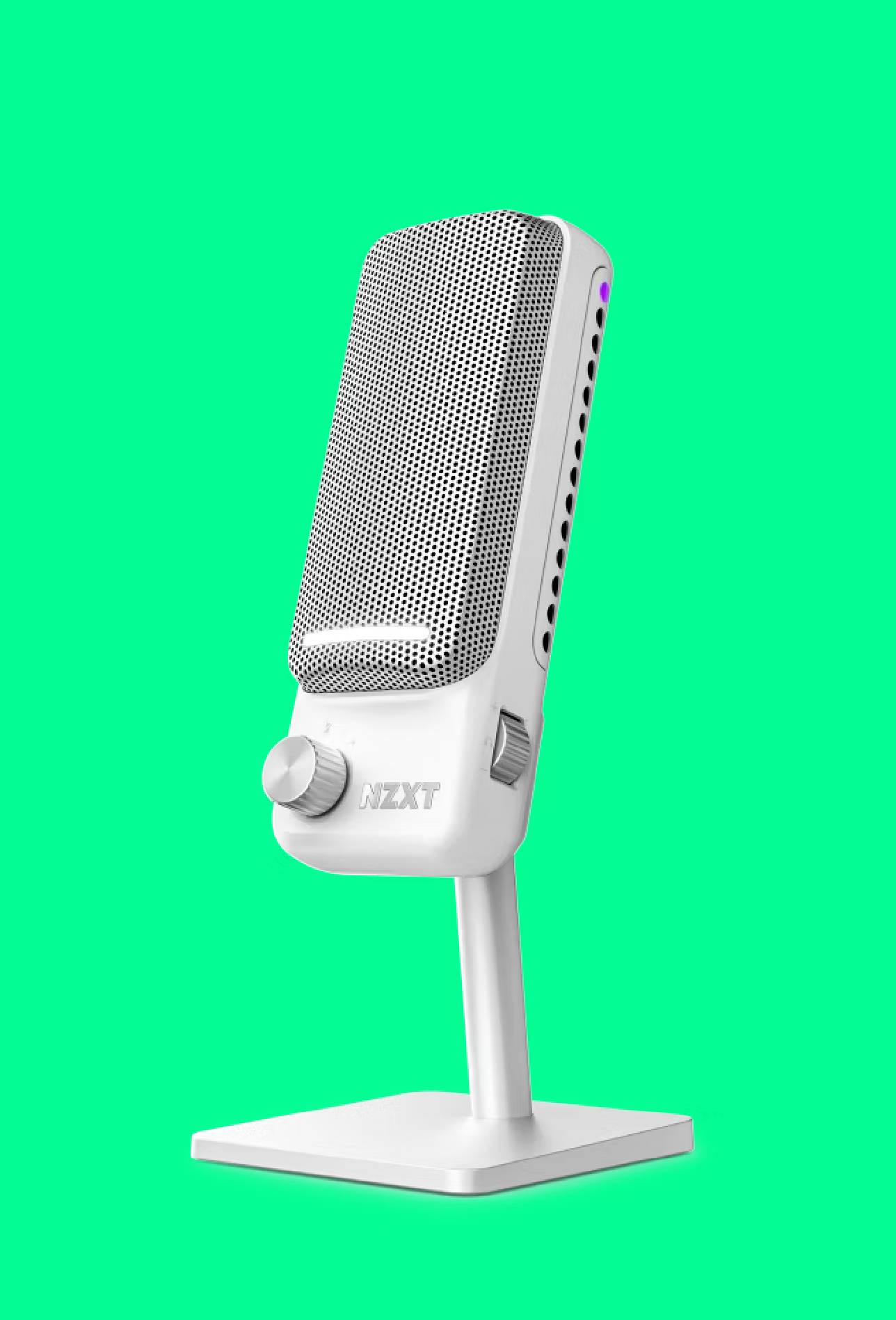
The best mid-range
For under $100, the NZXT Capsule Elite microphone delivers full, rich audio in a svelte design that competes with higher-end options. Well, apart from the mic body being plastic, that is.

The best USB bundle
The Sennheiser Profile Streaming Set is a great podcasting starter kit with a well-built mic and sturdy, quality boom arm, though the lack of a desktop stand single polar pattern makes it less versatile than we'd like.

The best looking
HyperX's signature microphone finds a new way to set itself apart from the competition. Spoiler: It's RGB lighting.

The best podcast microphone
The MV7+ actually manages to improve on the superb, studio-quality audio capture of the OG MV7. It's also so easy to use that even a novice can get an incredible sound out of it.
⬇️ Click to load more of the best gaming mics ⬇️

The best for streaming
The SteelSeries Alias Pro makes streaming simple, with a powerful interface and a great sounding mic. You'll need a separate boom arm to get the most out of it though.
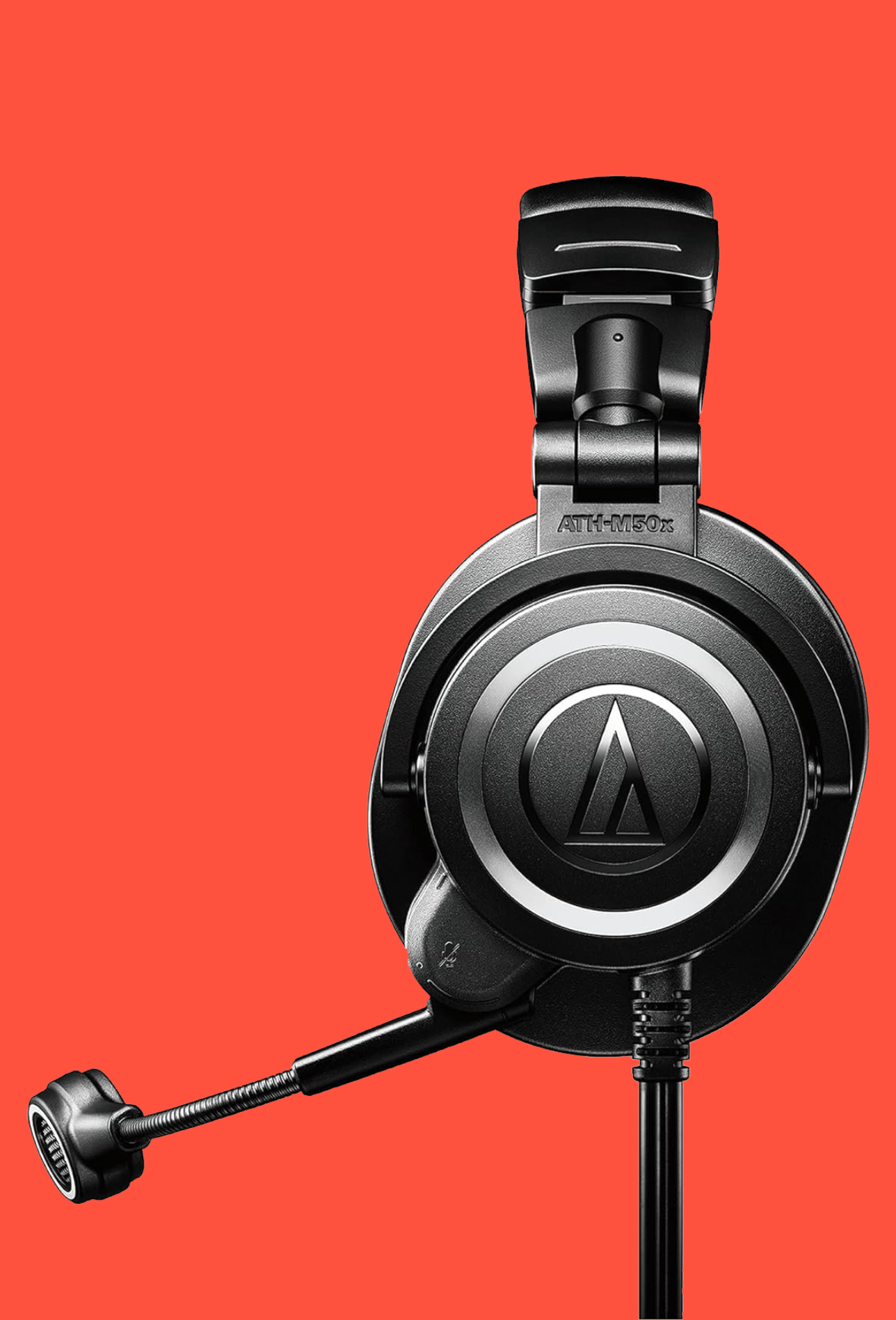
The best headset microphone
If you're looking for a headset mic that really delivers the goods, look no further. The ATH-M50xSTS StreamSet isn't just a great set of headphones but a great way of recording your vocals, too.
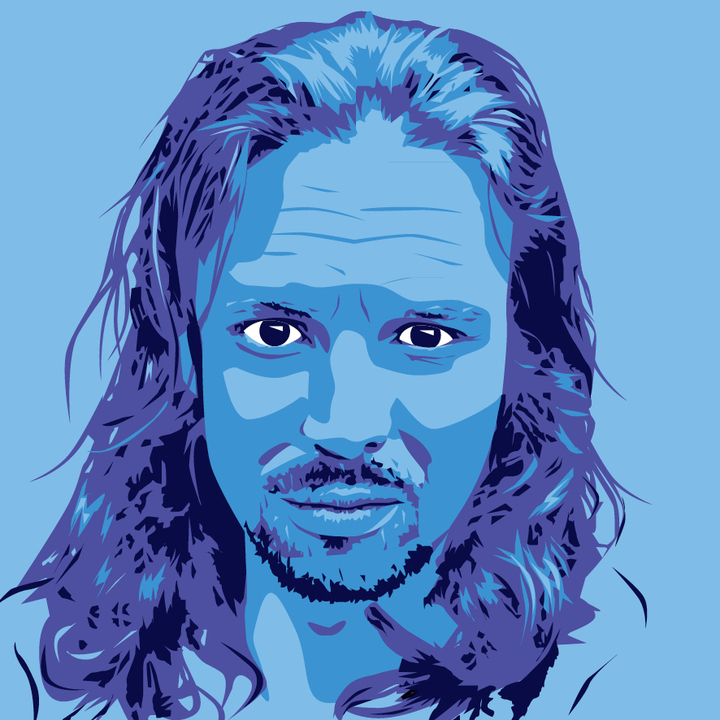
Andy's always been fascinated by sound. From his early days as a long-haired guitarist to his later years sitting on the opposite side of the glass, he's had the pleasure of using every type of audio equipment you can think of. He's also engineered and produced many a podcast—meaning that when it comes to the spoken word, he knows exactly which microphones to recommend, and which to leave well alone.
Updated June 2 2025 to give this guide a once over and ensure that all of our recommendations below represent the best microphones for gaming you can get right now.
Updated April 21 2025 to add in the Nacon Rig M2 Streamstar to our also tested section, and to check over our review copy and add in updated sound clips for some of our recommendations. All of our picks were checked for accuracy, and you'll be pleased to know they're still the best mics money can buy in 2025.
Updated March 6 2025, to make wording more precise and check over all of our recommendations to make sure we are recommending the absolute best mics out there.
The best microphone for gaming
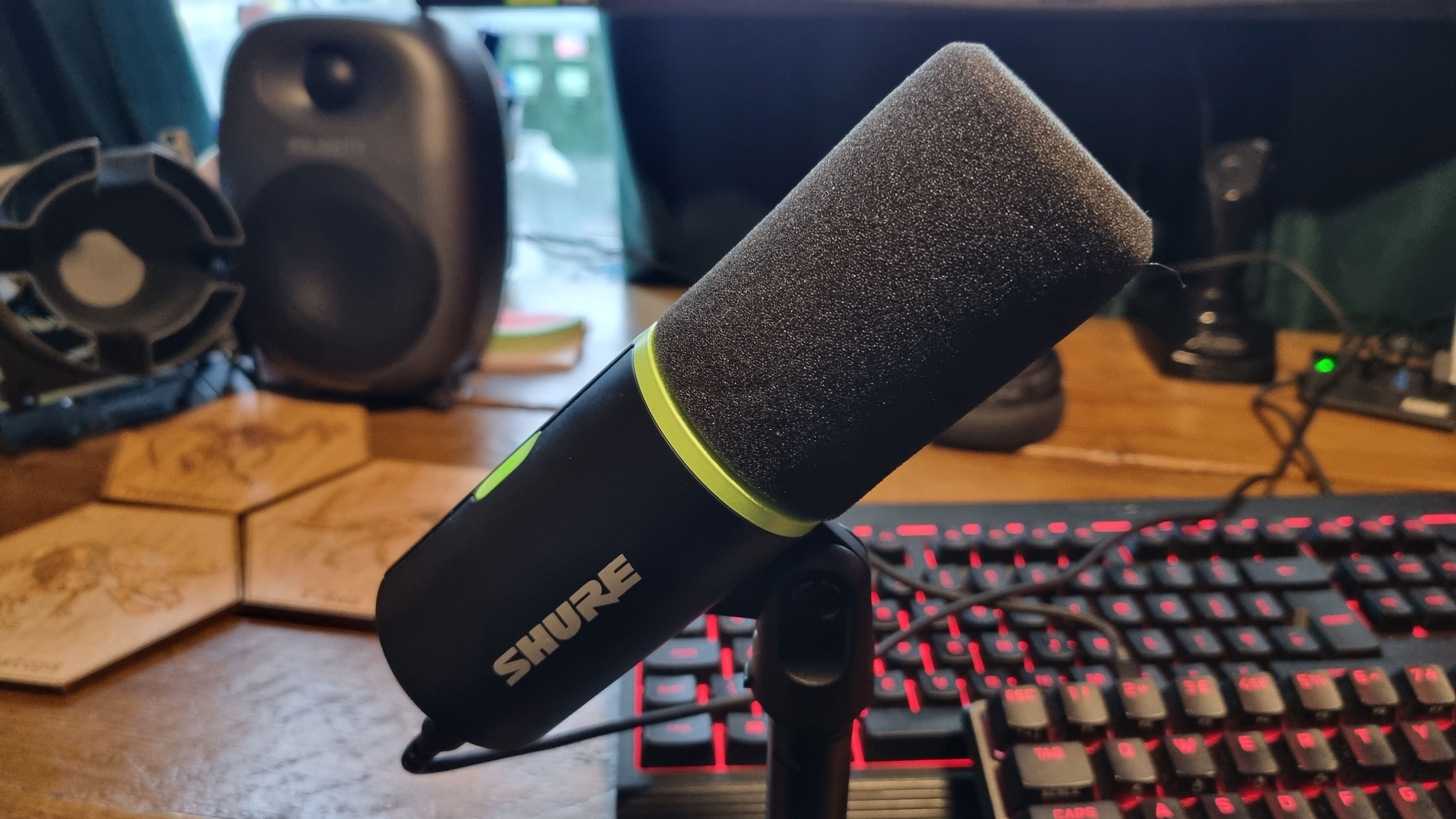







Specifications
Reasons to buy
Reasons to avoid
✅ You're looking for excellent sound quality: Desktop microphones can struggle to pick up good sound, but the auto levelling here makes the MV6 much, much better than most.
✅ If you want something straightforward: Shure's Motiv Mix software is mercifully easy to use, and all the fancy features like noise reduction are enabled by default.
❌ If you're on a tight budget: It's actually very reasonably priced for what you get, but there are cheaper mics available if you don't need to go quite as premium with the sound.
❌ If you're limited on desk space: The MV6 is far more reasonably sized than the MV7, but its chunky stand does take up a fair bit of room.
The Shure MV6 USB Gaming Microphone manages to pull off a very impressive party trick. We're massive fans of the podcast-friendly Shure MV7+, but here Shure has managed to shrink down some excellent, MV7-like vocal-capturing ability into something much more suitable to shoving on your desktop and letting it get on with the business of capturing great audio. You don't need to get it super close to your mouth to capture a great result, making the Shure MV6 the best gaming microphone we've used to date.
Let's talk about form factor for a moment. While you'll get the best results with a good microphone up close to your lips on a boom arm or similar, it's not exactly the most practical setup for most gamers. The MV6, however, is designed to sit on your desk at a more reasonable distance—capturing excellent vocals without being too precious about how far you sit from it.
It achieves this via the Motiv Mix software, which features auto gain-levelling to constantly adjust the volume, making sure you can always be heard. While it's not magic—and we'd still recommend getting reasonably close—it does an admirable job of keeping your voice consistent from a decent distance away, meaning you can focus on what's on-screen instead of perfect mic technique.
More than that, the built-in noise reduction is great at minimising ambient room noise, like PC case fans and humming radiators. It's actually a little on the aggressive side—meaning you can sometimes hear it overcompensating—but on the whole, it's a set-and-forget system that ensures you won't have to fiddle around to get a clean vocal signal.
You also get the pleasingly-named Digital Popper Stopper to minimise plosives if you do decide to get up close and personal for the full podcast-like sound. Of course, you can remove this mic from its stand and arm-mount it like other great mics, so there's real flexibility here, too.
Speaking of that stand, it's seriously chonky. There's absolutely no danger of this mic wobbling around, and it feels solid enough that you could use it as a boat anchor in a pinch. Shure has obviously learnt from its considerable live music experience and made a microphone and stand combo that feels nigh-on indestructible.
It does have a fairly considerable footprint, though. While it's much more compact than its MV7 forebearer, it's still pretty sizeable, so those looking for a more discrete solution might want to take a look at something truly tiny like the Razer Seiren Mini.
While the little Razer is great at what it does for the price, it does get outclassed here in terms of pickup and overall audio tone. In fact, so do most mics compared to the MV6, most of which aren't as svelte and as immediately useable as this one. To do better than this you'll need to spend up and get something truly professional right up in your grill, like the Shure MV7+ podcast microphone, which is a real gem of a mic. Here though, it's all about convenience.
The Shure MV6 is the mic to go for if you want something desktop-based, easy to use, and with excellent sound—and at $149, it's also very reasonably priced. That makes it the best gaming microphone you can place on your desk and one that'll likely keep on trucking for many, many years to come.
Read our full Shure MV6 USB Gaming Microphone review.
The best budget microphone




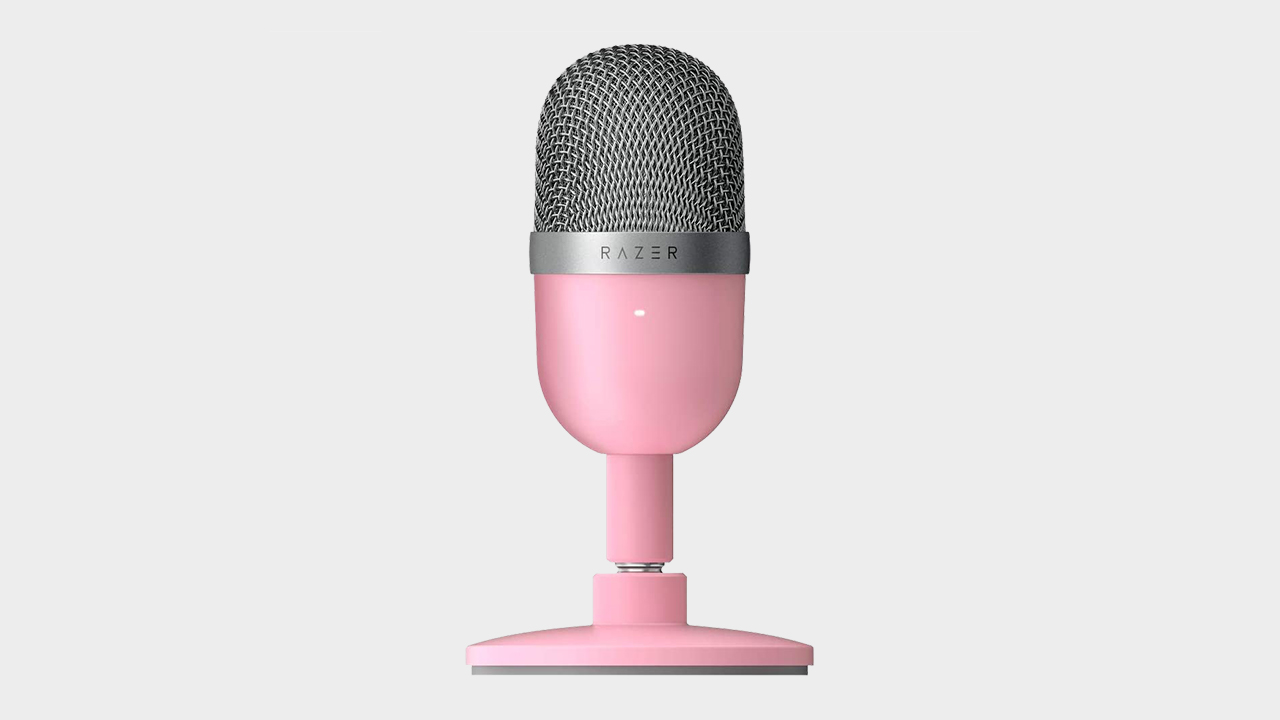
Specifications
Reasons to buy
Reasons to avoid
✅ You don't want to spend a lot for good audio: It might be light on features, but if all you're looking for is good sound quality for cheap, well, here you are.
✅ You like minimalist design: It's teeny, it's tiny, it's almost unbearably cute. That won't do it for everyone, but it's difficult not to be charmed by the aesthetic.
❌ You'd like a dedicated mute button: It might sound a bit picky, but a dedicated mute button on a mic is one of those things that you think you won't miss, but then probably will once you don't have one.
❌ You'd like to use your own cables: Yep, we don't like it either, but Razer insisted on using its own proprietary cable design. Boo.
The Razer Seiren Mini is our top budget microphone for streaming, and while it might skimp on features it still delivers top-notch sound for a mere $50/£50. If you're just looking to switch from a headset mic to a better-sounding desktop mic but don't want to have to mess around setting it up, the Seiren Mini is as plug-and-play as it gets.
The pill-shaped design here comes in a variety of Black, Mercury White, and Quartz, or as it's more commonly known, pink. It's an adorable-looking little microphone, which to some may seem more like a children's toy than a proper piece of audio equipment.
That would be a mistake, however, as the truth is that the little Razer sounds remarkably good for the money. Scrap that; it just sounds remarkably good in general. The internal capsule is of surprising quality given the price, meaning that its capture is warm, detailed, and clear all at the same time. Just what you want from any microphone, really, but it's especially impressive in one this cheap.
Nothing's perfect, and the Mini is, unfortunately, no exception. While the audio quality is brilliant for the money, it's still not quite going to compete with the really high-end gear like the magnificent Shure MV6. Also, it makes use of a proprietary cable design, which is a particular bugbear here at PC Gamer.
If it breaks, you're going to have to buy another one from Razer rather than getting a cheap replacement or digging one out from your cable drawer.
There's also no dedicated mute button, which is one of those things that doesn't sound like a huge deal but makes you feel a little unsure about the mic once you're using it. Having a switch on the mic itself to ensure that you definitely aren't transmitting audio is a reassuring feature, although this is almost certainly left out as a concession towards keeping the Mini as cheap as they come.
The simple fact that the Mini, at just $50/£50 (and in sales, we've seen it go as low as $35/£35), sounds as good as its more expensive brethren will attract users who just want a simple mic that looks elegant and sounds excellent. It's the best budget microphone by miles.
Read our full Razer Seiren Mini review.
The best mid-range microphone





Specifications
Reasons to buy
Reasons to avoid
Listen to the microphone in the test below:
✅ You want to sound like a podcaster: The full, rich sound that this cardioid mic delivers is reminiscent of some higher-end mics.
✅ You want to look like a podcaster: Despite its plastic body, the mic looks gorgeous, standing tall and looking rather professional.
❌ You want premium build quality: The stand is ever so slightly off-kilter (although it's stable) and is fiddly to screw in. Plus, while the stand is metal, the body is plastic.
The NZXT Capsule Elite promises a lot for its price and surprisingly delivers almost across the very wide board, which is why it's the best mid-range microphone. From noise rejection to adjustable features, it's got more than enough to compete with some higher-end options but for a fraction of the cost.
To look at the thing, you'd think it was a high-end, professional podcasting mic, and in a sense, you'd be right—until you get close and realise the mic body is made of plastic. But hey, there has to be some give, right? Overall it looks very suave, and its metal stand certainly helps with that, even if it is a little fiddly to screw in.
The stand-setting is the only part that's fiddly, though, as the mic itself is plug-and-play via a USB-C connection—it's great to see companies switching over to this smaller and newer USB format. The software's also easy to use, so you'll be configuring the Capsule Elite to your liking in no time.
And once you've got all that set up, boy does it deliver on the sound front. For a mic that comes in under $100, it's mighty impressive. You can hear what it sounds like above, and to my ears, that's a sound profile with tons of clarity, depth, and richness. We're talking a high bitrate, too, which certainly helps and is impressive at this price point.
It's a cardioid mic, so of course, you're not going to get the versatility of some multi-directional mics. But that's also to the Capsule Elite's benefit because the noise rejection that this thing offers is seriously phenomenal. In his review, our Reece found that music could be playing right behind the mic at a reasonable volume, and the mic would still only pick up his voice.
If you want to look and sound the professional podcaster or streamer, this mic offers a way into doing so for a fraction of the cost of what it seems like it should be. You get a smart-looking, great-sounding piece of kit, with an adjustable stand, colour-changing LED indicator, and even onboard monitoring via a 3.5 mm jack.
All those promises it truly does deliver on, with the only real sacrifice being its plastic body—which looks pretty damn good regardless, don't you think? Yeah, it's certainly a mid-range winner.
Read our full NZXT Capsule Elite review.
The best USB microphone and boom arm bundle




Specifications
Reasons to buy
Reasons to avoid
✅ You'd like a boom arm package: A good boom arm, in combination with a great mic close up, is a superb way to capture the sort of vocal recording you'd hear on a really good podcast or stream. You get it all here.
✅ You want clean, crisp sound: The Sennheiser sounds simply great. Really, genuinely great. That'll do then.
❌ You want a software helping hand: Nope, you don't get any. Bit of a shame that. While good free versions of audio streaming and sound adjustment software do exist, they can be a bit fiddly, so an included solution would have been nice.
The Sennheiser Profile Streaming Set gives you everything you need to start your podcasting or streaming journey with a great-sounding microphone and sturdy boom arm combo for less than $200. That makes it our top recommendation for the best USB microphone and boom bundle.
The Profile has two versions: the standalone microphone for $129/£129 or the Streaming Set for $199/£179. We'll take the latter, thanks, as it's a great deal for a full set that means you have everything you realistically need for great, studio-quality audio.
The volume and mix controls are well placed, and the dedicated mute button is one of those features you probably wouldn't care much about on paper but makes all the difference in practice. Having a physical button to ensure you're muted helps avoid any awkward streaming audio-related accidents. Look, Mum, I know dinner's ready. Can't you see I'm recording games for the internet over here?
More than that, the Profile is wonderfully warm in its audio quality, with a crisp level of clarity that just makes your voice sound great. Sennheiser knows what it's doing when it comes to sound, and the Profile captures your vocals beautifully, ensuring it's just down to your performance rather than too much fiddling with the dials.
Speaking of dials, on the software front, you'll be reliant on using free or paid audio tweaking software if you want to engage in sonic trickery. That being said, the sound is good enough that you shouldn't need a lot, if any, to still sound great. It must be mentioned, however, that setting up a good stream can be a fiddly procedure—and if you'd rather have something that came with an interface and software package that made it easy, it'd be worth taking a look at the SteelSeries Alias Pro below.
Other letdowns? Well, it's very much a microphone just for you rather than you and your friends, as it only has the one pattern that captures the audio right in front of it rather than the whole room. Still, chances are if you're bringing your buddies in for a group session, you'd want to use more than one mic, although it is worth pointing out that mics like the HyperX Quadcast S do have the facility for multiple polar patterns if you'd like some more flexibility.
Also, if you pick the boom arm version, you won't receive the desk stand. It's a bit of an omission, but again, this is designed to get right in your face and capture great audio, so a desk stand would maybe do it a slight disservice.
The boom arm itself is excellent, thankfully, and is as flexible and resilient as you like, so what you're getting here is something that you can use again and again, and probably again, too. Good boom arms can sometimes be expensive, but here, it's all part of the package.
Yep, it's a great stream companion this, or a massive boost to meeting audio, in-game voice chat or a podcast, and a very well-thought-out package that hits all the right notes.
Read our full Sennheiser Profile Streaming Set review.
The best looking microphone

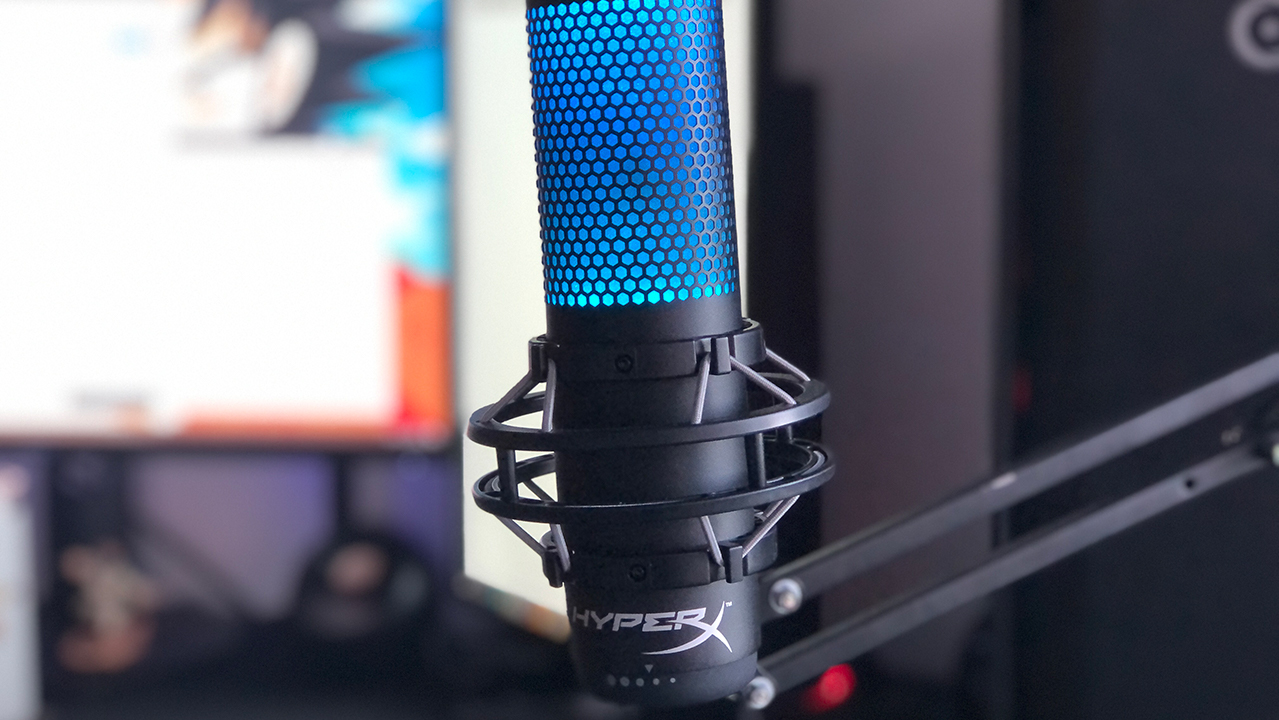





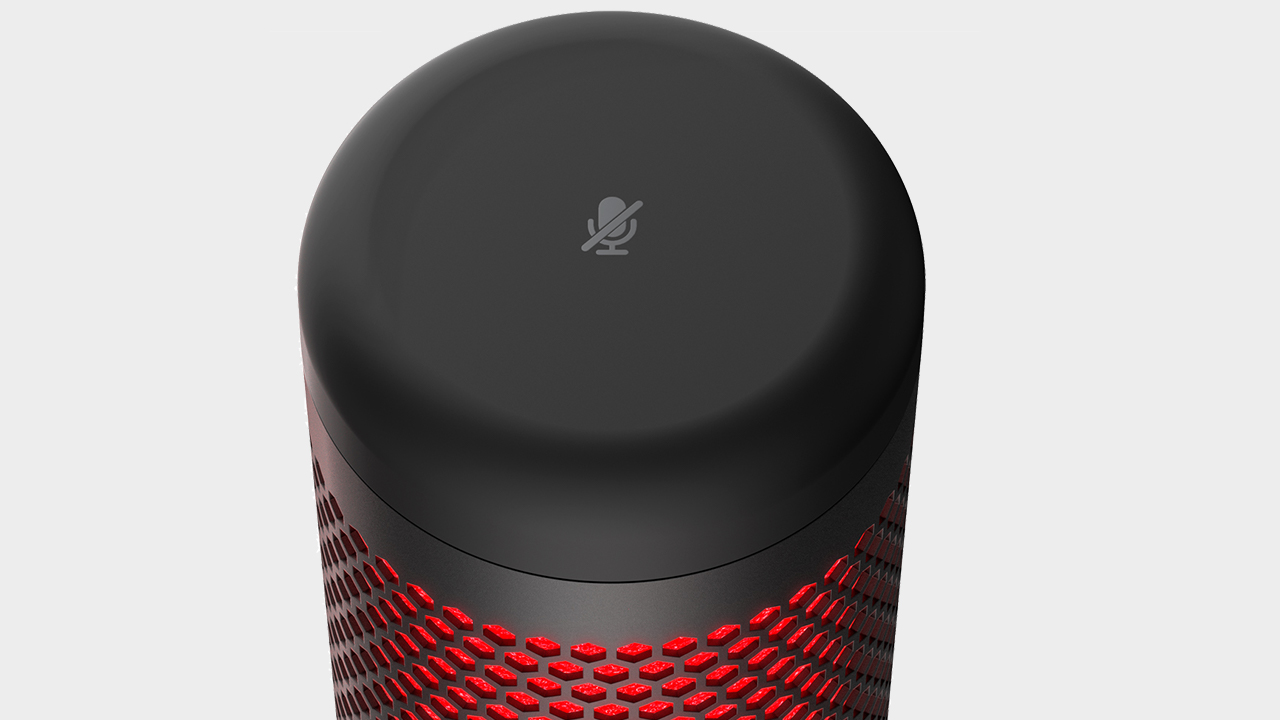
Specifications
Reasons to buy
Reasons to avoid
✅ If you want RGB, and an entertaining aesthetic: The HyperX looks fantastic on camera and luckily doesn't sacrifice audio quality to do it.
✅ You want loud and clear audio: It might be an older spec capsule, but to be honest, there wasn't a whole lot wrong with the original. There are nicer sounding mics, sure, but there's nothing wrong with the audio quality here.
❌ The software package is light: It's got software, but it's mainly about adjusting the RGB (did you see what I did there?). Some more audio-wrangling settings would be nice, but what's there is functional, at least.
The gamer-centric HyperX Quadcast S is an excellent microphone for the gamer or streamer looking for an easy-to-use, clear-sounding mic, and it takes our top spot for the best looking. It might seem a bit strange to think about looks when buying a microphone, but if you've got your audio gear in the shot, it'd be nice if it looked great as well as sounding it, dontcha think?
More than just a looker, however, the Quadcast S has plenty of features that you usually end up paying more for in other mics. The built-in pop filter works well (and contributes to the sleek aesthetic rather than covering your fancy new mic with an add-on attachment), and the top-mounted tap-to-mute button is capacitive, meaning there's no audible click when it's activated.
In terms of software, the Quadcast S makes use of HyperX's Ngenuity suite, and there are options to adjust the lighting, gain, and, err, not a whole lot else. Still, it's straightforward at the very least, but if you're expecting a lot of bells and whistles, you'll come away disappointed. Straightforward to a fault, but with all the basics covered, it will have to do.
When it comes to sound, the Quadcast S captures clear and crisp audio even on low gain settings, although it must be said it's a little plosive-prone. Still, the sound profile leans towards clarity without becoming harsh, which means it's a very good fit for anyone looking to do a bit of live streaming or podcasting.
And after all, it seems a shame to keep all that lighting to yourself. It's got a rare combination of streamer-friendly good looks and excellent audio for a reasonable price, and those looking for something both aesthetically and sonically pleasing are well-catered for here.
Of course, you could go for the standard Quadcast and get, well, almost everything advertised here without the RGB for around $20 cheaper. Still, if style is important to you as well as excellent audio, the HyperX Quadcast S is the best looking by far.
Read our full HyperX Quadcast S review.
The best podcast microphone





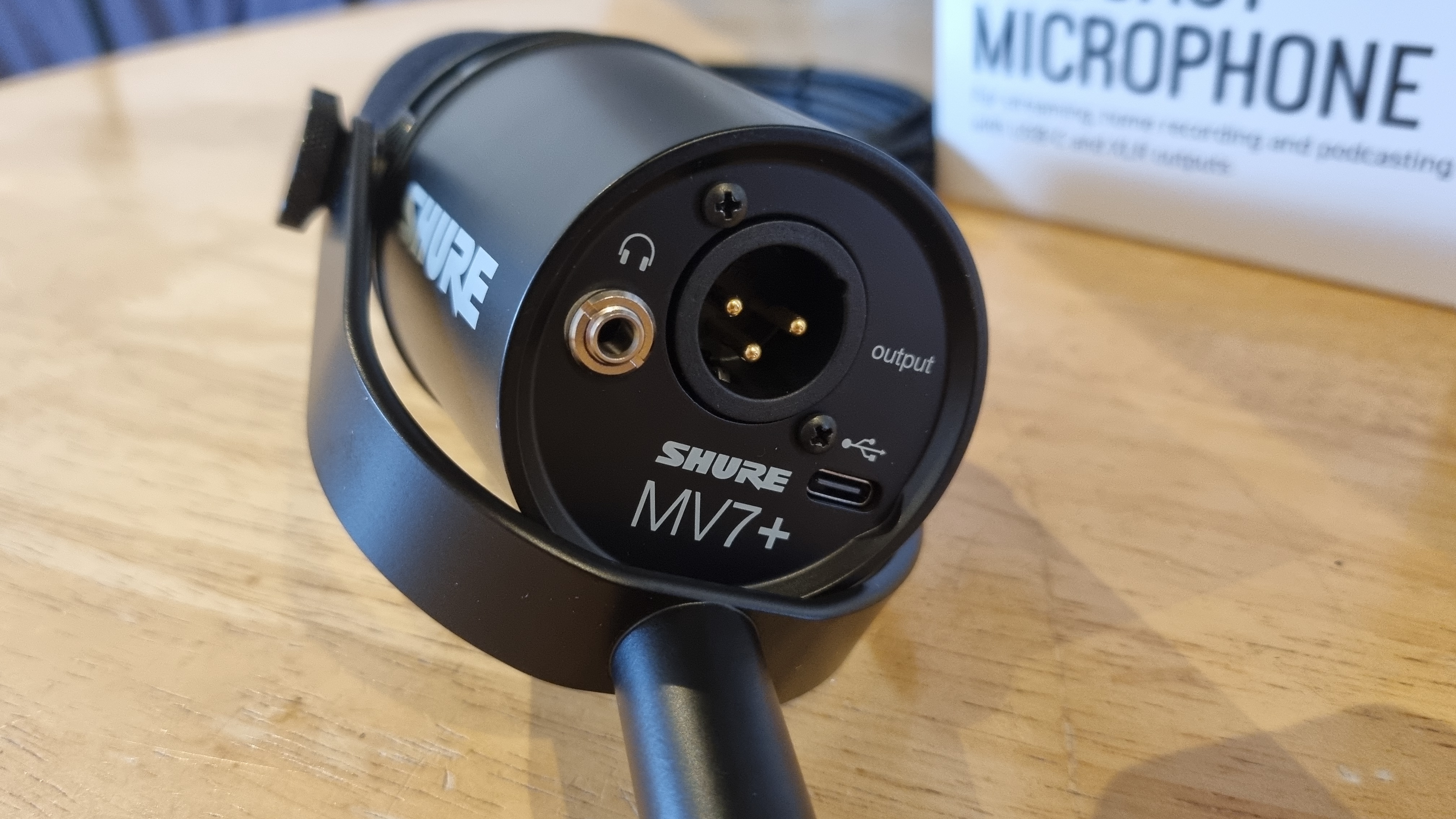


Specifications
Reasons to buy
Reasons to avoid
✅ You want professional-sounding results without the hassle: Install the software, plug in the mic, and off you go. Studio-grade sound has never been easier.
✅ You want something built to last: Shure mics are as tough as they come, and this one feels no different.
❌ You don't want a microphone in your face: The Shure is really at its best when it's mounted close to your mouth, which means you'll need a boom arm (which costs extra) to get the most out of it.
❌ You're on a budget: There are cheaper mics on this list that'll do a great job. It's well-priced for what it can achieve, but if decent audio on a budget is your goal, this may be more than you need.
When we heard the original Shure MV7 was being replaced, our hearts sank. That was a microphone that sat at the top of this guide for a very long time, only recently replaced by the Shure MV6 as our top gaming mic. We needn't have worried, though: its replacement, the Shure MV7+ Podcast microphone, is even better than its predecessor.
The really astonishing thing about this mic is how easy it is to get a studio-quality sound. Simply install Shure's Motiv Mix software, plug it in via a Type-C USB connection with the included cable, and begin recording. That's not just because it's a great mic. Shure's software gets to work turning on all the bells and whistles, including noise reduction, Auto Gain levelling, and a Digital Popper Stopper, from the moment you plug it in.
On that note, that was one drawback of the original Shure MV7: it was a little prone to plosives, which are percussive sounds like "puh" that can become blown out if you speak into it too forcefully. Thanks to a bit of extra foam and the aforementioned digital helping hand, however, plosives are no more with the MV7+.
It sounds superb on its default settings, with a rich warmth, pin-point accurate vocal capture, and a lovely, crispy, "hot radio" kind of sound—with no fiddling required. The MV7+ simply gets up and goes, and as a result, you don't need to know anything about audio to get a professional result out of it.
That doesn't mean there aren't caveats, however. You'll need to get it up close, like a proper pro podcaster or streamer, to get the most out of it, which will necessitate buying a boom arm. Sure, you can use it with a separate desktop stand (which costs extra) just fine, but it's right next to your face that you'll really hear the full benefits—and while Shure will sell you the appropriate stand/arm, it still doesn't come with either by default.
The other thing is the price. At $279/£269, this isn't a cheap bit of equipment. However, given just how easy it makes capturing a studio-grade result in your home, that's actually pretty fair, given that it's competing with proper professional microphones that can cost much, much more.
It'll be fantastic for streaming too, although we still recommend the SteelSeries Alias Pro for streamers, mainly because it includes a handy mixer for switching settings on the fly. That's even pricier, though, and if you don't need those controls then the MV7+ is the better pick.
So why's the MV7+ not at the top of this guide as the best gaming mic? Well, the Shure MV6 is smaller, sits on your desk, and is substantially cheaper, too. But if you don't mind getting a larger mic up close for the best possible sound—and opening your pocketbook a fair bit wider—this is the one to pick.
Read our full Shure MV7+ Podcast microphone review.
The best microphone for streaming




Specifications
Reasons to buy
Reasons to avoid
✅ You're looking for something more than a desktop microphone: The Alias Pro performs fine on a desk, but that included Stream Mixer brings quick switching to the party.
✅ If you want to start streaming without the fuss: Streaming audio can be a pain, but the Sonar software, in combination with the flexibility of the Stream Mixer, makes it easier than most.
❌ If you're not looking to spend a lot: That extra interface comes at a cost, and that cost is, err, money. Plus an arm. Cheap, this isn't.
❌ If you're not going to use it with an arm: The Alias Pro sounds about the same as the regular Alias on a desk, which is to say, pretty good. Still, it'd be a waste not to take advantage here by getting it close up.
Setting up a stream with great audio is traditionally not easy, which is the reason we're sticking the SteelSeries Alias Pro in as our best microphone for streaming. It might be pricey, but what you're paying for here is really the Stream Mixer that comes with it, and all the streamer-friendly features that make it a fantastic buy, even if it is pricey at a $330/£330 MSRP.
That little two-dial, two-button unit contains a powerful preamp that can connect out to an XLR microphone with 48V phantom power, which means you can use this with just about any good XLR mic on the market. However, SteelSeries has provided you with one of its Alias units here, and thankfully, it's a bit of a peach. It sounds lovely, particularly close up with a bit of an adjustment, although we'll get to that later.
Once you've booted up the Sonar software, you'll discover it takes away most of the strain of setting up a load of complicated inputs, outputs and audio gear. Drop-down menus and great hardware/software discovery mean that this package does its best to make all those confusing settings as straightforward as possible, and the RGB-lit buttons and dials on the front of the interface can be programmed in a variety of ways to make streaming control easy.
More than that, the included audio-adjustment settings are simple to use. There's a compressor, ClearCast AI-noise reduction and a straightforward EQ with plenty of useful presets, which means getting a good sound out of this setup is easy. However, there is a bit of a catch.
The SteelSeries Alias Pro really, really appreciates being up close, and that means using a boom arm to get the microphone right up to your face. That'd be all well and good, except SteelSeries doesn't provide one with the package, limiting you to a desk stand instead.
It'll sell you its own version, the SteelSeries Alias Boom Arm, for another $100—but in all honesty, it's a bit overpriced for what it is. Thankfully, the socket at the back of the SteelSeries Alias mic provided here is a standard size, so many cheaper and just as good third-party boom arms should fit.
And you're going to want one. Up close, the SteelSeries Alias Pro really shines, and great streaming audio becomes easier to achieve thanks to that software package and the quality of the 1-inch capsule provided.
It's also small and compact, which means it's not quite as in-your-face as something like the Shure MV7+ might be, although if you're looking for ultimate audio chops, the Shure still takes the crown for the best sound. It's also as simple as can be to use, although it doesn't have a mixer for switching streaming settings on the fly.
Streaming audio is difficult, and audio interfaces can be complicated beasts to wrangle. The SteelSeries Alias Pro takes as much hassle out of the process as it can, and that makes it the best microphone for streaming. Just make sure you price in an arm (or, given the cost, even a leg) to get the most out of it.
Read our full SteelSeries Alias Pro review.
The best headset microphone





Specifications
Reasons to buy
Reasons to avoid
✅ You don't want a desk microphone: If you'd like a mic and a headset all in one without the fuss, then this combo delivers exceptional audio quality on all fronts.
❌ You're after a cheaper option: You could buy a gaming headset and the best budget microphone for less, although the quality on offer here is well worth considering regardless.
Desktop mics are all well and good, but if you're looking for the best headset microphone, it has to be the Audio-Technica ATH-M50x STS StreamSet. With this substantial piece of gear, not only are you getting a brilliant microphone but a very good set of wired headphones all-in-one.
This headset features a proper, fully-fledged cardioid condenser mic. Don't let the relatively small size of that end capsule put you off—this unit is easily the best headset mic we've ever tested and is capable of capturing your vocals just as well as some of the other options on this list.
There's a lot to be said for having an excellent microphone built into a headset, too. For a start, you won't have to worry so much about volume changes when moving around, as once the mic distance has been set with the bendy arm, that's where it'll stay. That makes it perfect for those who don't want to think about their mic technique while gaming, as once you've got the distance right, you really don't have to think about much else.
With a range of sampling options, there's plenty of flexibility on offer. Plus, there's a monitor mode. Ordinarily, that can be pretty distracting, but we found that the version here was actually very useful for keeping an eye on your vocals while mid-stream.
Not only that, but noise-removal software shouldn't be necessary given the closeness of that mic to your speaking equipment (i.e. mouth). There it'll hover, picking up your vocal tones and not much else unless you really, really crank the gain to the guns.
There are a couple of downsides to consider. One is the lack of on-headset or on-wire buttons, which for some will be a bonus in terms of simplicity. A dedicated mute wouldn't go amiss, though. The other is the price. At $229/£169, the Audio Technica is on the pricey side for both a good mic and a good headset, although, of course, you're getting two in one. The ATH-M50xSTS really is good at two, often quite separate, roles. Together, combined, it really does excel at both.
When it comes to headset microphones, it really is one of the best we've ever used. And for good measure, the drivers themselves are absolutely brilliant, too. Pricey, perhaps, but multi-talented and built to last, to boot.
Read our full Audio-Technica ATH-M50x STS StreamSet review.
Also tested
Nacon RIG M2 StreamStar
While the M2 Streamstar captures decent audio close up, it's prone to picking up unwanted noise, and has zero software to help you deal with it. That's a real shame, especially given the price.
PC Gamer score: 47%
Read our full Nacon RIG M2 StreamStar review.
Audio-Technica AT2020+
One of the best budget mics you can buy right now that's easy to use, provides crisp audio, and is built to last.
PC Gamer score: 89%
Read our full Audio-Technica AT2020+ review.
Razer Seiren V3 Chroma
It's got superb lighting, simple controls and a naturally warm and pleasant sound, but a lack of noise suppression software in combination with a wide range means it picks up unwanted audio a little too easily.
PC Gamer score: 67%
Read our full Razer Seiren V3 Chroma review.
SteelSeries Alias
A well-built and compact unit with excellent range, and it works brilliantly with SteelSeries' Sonar audio software and its powerful AI noise-cancelling tool. Unfortunately, it's overpriced compared to the competition.
PC Gamer score: 79%
Read our full SteelSeries Alias review.
Asus ROG Carnyx
It's a good-looking mic and built very well. However, a lack of feedback from the onboard controls and a slight sound disadvantage compared to its nearest rivals puts it slightly on the back foot.
PC Gamer score: 67%
Read our full Asus ROG Carnyx review.
How to spot the best deal
Gaming microphone FAQ
What is a polar pattern and which do I need for gaming?
A polar pattern determines how much and from which direction an audio signal will be picked up by a microphone. For gaming, you'll mostly want a pattern that picks up sound directly in front of the microphone (you) and not much else from anywhere else (the environment).
These are the most common polar patterns:
Cardioid: Records in front of the microphone. Perfect for voice-over, vocals, and streaming.
Bidirectional: Captures audio in front of and behind the mic. Ideal for one-on-one interviews.
Omnidirectional: Picks up sound from every direction. Perfect for round-table interviews, but not so much for gaming or streaming.
Stereo: Perfect for ASMR recordings. YouTube 'ASMR' if you want the best example because I couldn't do it justice.
Do I need a microphone boom arm, shock mount, or pop filter?
Everyone’s desk and setup requirements are different, so a mic must perform well under a handful of different scenarios. Suppose a microphone sounds better than all the rest combined, but only when it’s on a suspended mic stand with a shock mount positioned precisely six inches away from your mouth. In that case, it’s not necessarily a reliable option to recommend.
Saying that, however, there are some valuable bits you might want to pick up if you're looking to clear away clutter or build a more professional setup.
A boom arm certainly helps achieve both of those things. These almost always clip onto the side of your desk and are super handy to keep your mic close to hand while off your desk, saving precious real estate.
While a pop filter will help reduce plosives, the sound of air escaping violently from your mouth and towards the mic, from making their way over to airwaves to your listeners' unfortunate ear holes. It'll also stop your microphone from getting grubby when you're up close and sounding sibilants.
A shock mount is perhaps the least necessary of the lot, at least for gaming. These prevent vibrations from travelling through your microphone stand or boom arm and into the microphone, which can come through as rustle, thuds, or otherwise unwanted noise. Certainly a must-have for music studios, unless you are one to slam your way through a match of Apex Legends, you might be okay without.
What's is a good sample and bit rate for a microphone?
Sample rate is the number of audio samples recorded every second. 48 kHz is the most common sample rate you'll see on many microphones, and it shouldn't be any lower than that.
Bit rate is the speed at which a digital and audio file gets encoded. Without trekking too much into audiophile territory, 16-bit and above is considered a good bit rate.
What connector do I need? XLR or USB?
USB microphones are among the most prevalent for gaming and streaming fare, but you'll sometimes see the more widely used professional connection standard, XLR, make its way into high-end units. Hybrid USB/XLR can offer you the best of both worlds but tends to be more expensive.
USB is the simpler of the two, and if you're looking for plug-and-play ease, then it's your best bet. However, that simplicity comes at a cost. It's difficult to record more than one USB microphone simultaneously, and monitoring and adjusting the mix will be done digitally.
With the added complexity of XLR comes a great deal of flexibility that you otherwise wouldn't be able to access without even more complex digital mixing software on a USB mic. You can mix, adjust, and monitor an XLR mic before it ever touches your PC, and that's a massive boon if you're looking for a more complex setup.
The downside to XLR is that it will require additional equipment to connect to your PC. It is nothing wild, just something to interface between the mic and PC, such as the many devices by that name, which often come with a mixing functionality built-in.
How much should I spend on a microphone?
As PC gamers, we will, of course, always try to get the best we can for less. It’s easy to get lost in the deep, dark woods that are the world of audio and even easier to spend a ludicrous amount of time and money chasing the best possible setup. But we don’t need studio-ready equipment, so the price is essential when looking at how good a particular mic is.
Think about your use case; if you're only using a microphone to chat with your teammates, chances are you don't need a microphone with half a dozen polar patterns and a podcast studio level of quality. Don't spend money on features you don't need or use. Some $50 or fewer microphones are more than adequate and great for gaming. We picked out the best budget microphones that we have tested this year if you need some guidance.
Keep up to date with the most important stories and the best deals, as picked by the PC Gamer team.

Andy built his first gaming PC at the tender age of 12, when IDE cables were a thing and high resolution wasn't—and he hasn't stopped since. Now working as a hardware writer for PC Gamer, Andy's been jumping around the world attending product launches and trade shows, all the while reviewing every bit of PC hardware he can get his hands on. You name it, if it's interesting hardware he'll write words about it, with opinions and everything.
- Reece BithreyContributor
- Jorge JimenezHardware writer, Human Pop-Tart
- Hope CorriganHardware Writer






